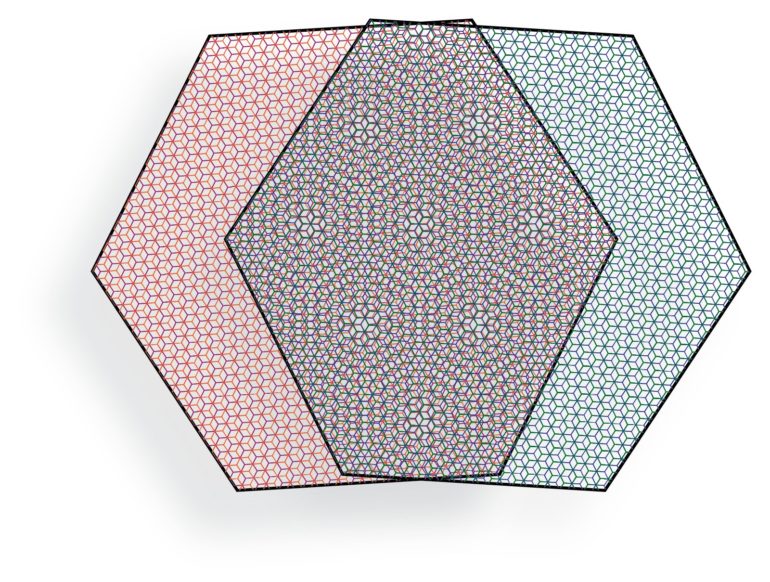Over the past few years, a growing number of researchers worldwide has been conducting studies investigating the properties and features of so-called twisted van der Waals (vdW) materials. This unique class of materials could be an ideal platform to examine correlated phases that occur as a result of strong interactions between electrons.
Researchers at University of Washington and the National Institute for Materials Science in Japan have recently carried out a study specifically exploring correlated insulating states that can occur in twisted vdW heterostructures and that could be tuned by changing the twist angle and applying an external electric field. In their paper, published in Nature Physics, they present electrical transport measurements of twisted double-bilayer graphene, from which they were able to examine the role of spontaneous symmetry breaking in the material’s phase diagram.
Condensed matter physicists have known how to isolate single monolayer sheets of materials such as graphene for over 15 years using a Scotch tape exfoliation procedure. They now also know how to pick up thin atomic sheets individually and assemble them on top of one another. If they are rotated by a small twist angle, a geometric interference pattern called moiré pattern emerges. This pattern can strongly modify the electronic properties of a composite structure.
“In certain cases, the moiré pattern can result in spectacular new electronic states that are driven by strong interactions between the electrons in the material,” Matthew Yankowitz, assistant professor of Physics and Materials Science and Engineering at the University of Washington, who carried out the study, told Phys.org. “This was first discovered in 2018 by researchers at MIT, who observed superconductivity and correlated insulating states upon stacking two monolayer graphene sheets twisted by 1.1° (i.e., magic-angle twisted bilayer graphene). These correlated states are especially exciting because they reside in a stoichiometrically simple structure composed entirely of carbon atoms and can be tuned dynamically using a number of experimental knobs like charge doping, twist angle and pressure.”
Similar correlated states have also been previously observed in bulk crystals, yet in these materials, they were far more difficult to tune and to theoretically model due to the crystals’ complex structures. Understanding these strongly correlated states thus remains a key challenge in condensed matter physics.
The goal of the recent work by Yankowitz and his colleagues was to gain insight on how these correlated states in vdW heterostructures can be used in research and technology development. Shortly after they were first spotted in magic-angle twisted bilayer graphene, research teams worldwide realized that these states could also be found in heterostructures containing two twisted sheets of bilayer graphene (i.e., four graphene layers in total).
“In this case, the correlated states could additionally be controlled by an electric field applied perpendicular to the graphene sheets,” Yankowitz explained. “However, the exact nature of these states remained somewhat mysterious. In particular, there were features resembling an exotic form of superconductivity, however, the exact origin of these features was not well understood. The primary motivation of our study was to address these questions by studying twisted double-bilayer graphene with electrical tunability.”
As part of their study, Yankowitz and his colleagues measured electrical transport as a function of temperature and magnetic field. When there is a small magnetic field, the sign of resistance transverse to the applied current, which is known as Hall resistance, indicates what type of subatomic particles (i.e., electrons or ‘holes’) are the primary charge carriers inside a material.
When correlated states spontaneously break a symmetry (i.e., either electron spin or valley symmetry) in twisted double-bilayer graphene at low temperatures, the material’s electronic structure rapidly changes, and its primary charge carriers can also change. Therefore, simultaneously measuring the material’s resistivity and Hall effect can offer valuable insight about the correlated states within it.
“By carefully measuring the resistivity and Hall effect of twisted double-bilayer graphene as a function of temperature, we found that the abrupt resistivity drops, reminiscent of superconductivity, were also associated with a simultaneous sign change in its Hall resistance,” said Xiaodong Xu, professor of Physics and Materials Science and Engineering at the University of Washington. “This observation is more consistent with the onset of magnetic ordering owing to spontaneous symmetry breaking than with superconductivity.”
Interestingly, the resistivity drop observed by Yankowitz, Xu and their colleagues in twisted double-bilayer graphene undergoes the sharpest change as a function of the temperature at the boundary of the symmetry-breaking states. As part of their study, the researchers also investigated transport as a function of the bias caused by an applied electrical current.
When they applied a current to the material, they observed signatures associated with non-linear transport. Although non-linear transport is also observed in superconducting states, they found that in their sample it was most likely a result of Joule heating mechanisms.
“Our work provides a critical new understanding of previously mysterious features associated with correlated states in twisted double-bilayer graphene,” Yankowitz said. “Although we cannot directly rule out superconductivity, our results suggest that magnetism driven by spontaneous symmetry breaking is a plausible candidate for the correlated metallic state in twisted double-bilayer graphene.”
In recent years, superconductivity-like features similar to the one examined by this team of researchers have been observed in a wide variety of moiré vdW heterostructures. The new findings they presented could help to differentiate these states from the superconductivity that past studies unveiled in magic-angle twisted bilayer graphene.
In addition, the observations collected by Yankowitz, Xu and their colleagues could help to better understand the nature of correlated states in moiré vdW heterostructures from a theoretical standpoint, which has so far proved highly challenging. The researchers are planning to use the insight they gained to develop more direct probes for understanding these states.
“Since our results suggest that the correlated metallic states are magnetically ordered, we would like to observe direct signatures of this magnetism using a combination of electrical transport and optical spectroscopy,” Yankowitz said. “We are also investigating new ways to control these correlated states, for instance by applying high pressure to modify the interlayer coupling and crystal structure of the material. Finally, theory predicts that this material may host topological states, like the quantum anomalous Hall effect, so we are now looking into ways to expose and probe this non-trivial topology.”
Stacking and twisting graphene unlocks a rare form of magnetism
More information:
Symmetry breaking in twisted double bilayer graphene. Nature Physics2020. DOI: 10.1038/s41567-020-1030-6.
Provided by
Science X Network
2020 Science X Network
Citation:
Study examines spontaneous symmetry breaking in twisted double bilayer graphene (2020, October 15)
retrieved 15 October 2020
from https://phys.org/news/2020-10-spontaneous-symmetry-bilayer-graphene.html
This document is subject to copyright. Apart from any fair dealing for the purpose of private study or research, no
part may be reproduced without the written permission. The content is provided for information purposes only.



